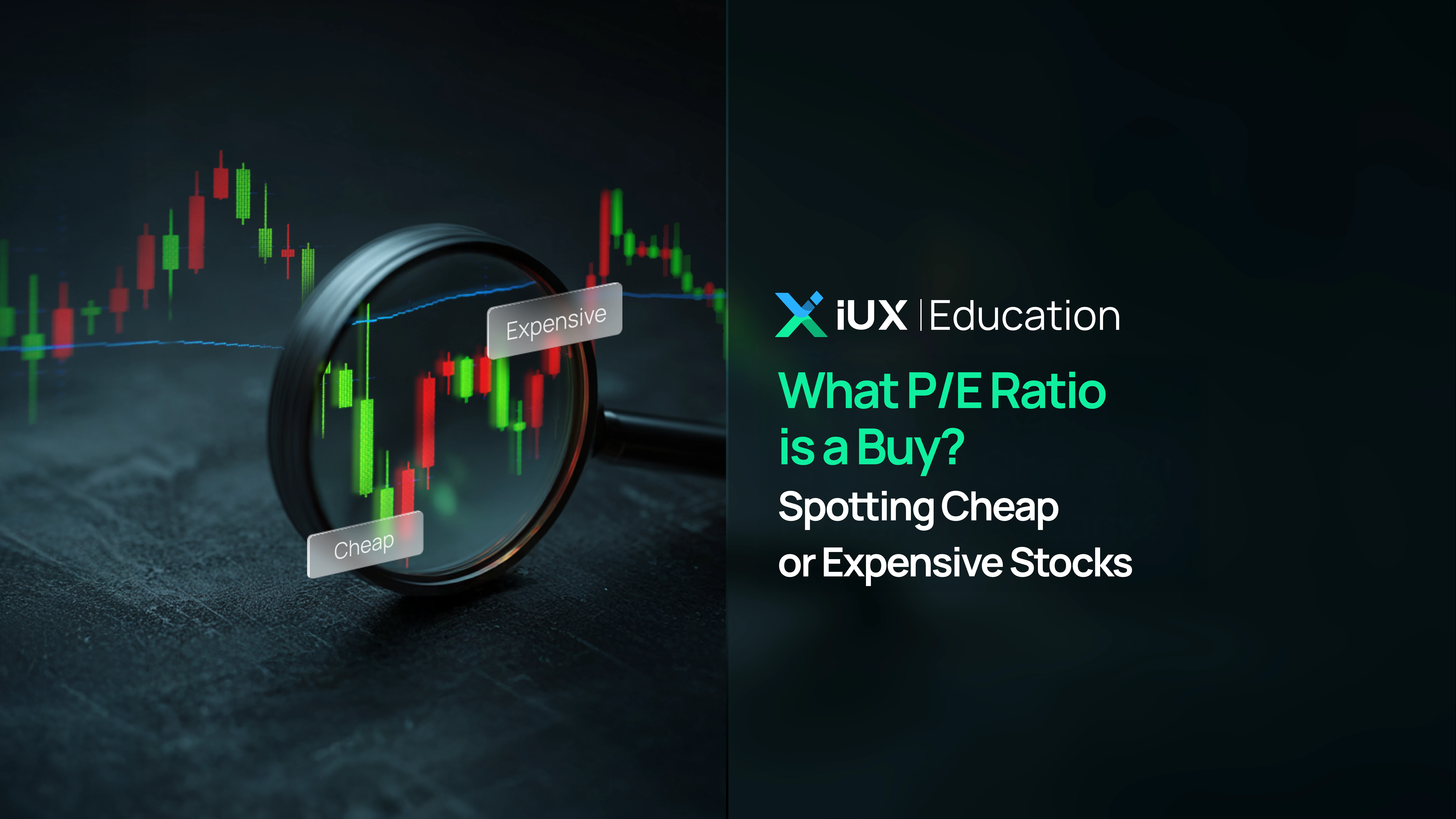Os CFDs são instrumentos complexos e envolvem um alto risco de perda rápida de dinheiro devido à alavancagem. 76% das contas de investidores de varejo perdem dinheiro ao negociar CFDs com este provedor. Você deve considerar se compreende como os CFDs funcionam e se pode correr o alto risco de perder o seu dinheiro.
Os CFDs são instrumentos complexos e envolvem um alto risco de perda rápida de dinheiro devido à alavancagem. 76% das contas de investidores de varejo perdem dinheiro ao negociar CFDs com este provedor. Você deve considerar se compreende como os CFDs funcionam e se pode correr o alto risco de perder o seu dinheiro.

What P/E Ratio Is a Buy? How to Spot Cheap or Expensive Stocks
What P/E Ratio Is Considered "Cheap" or "Expensive"?
Before buying or investing in the stock market, most investors use the P/E ratio as a basic metric to compare a stock's price with its earnings per share (EPS). For example, if a stock has a P/E ratio of 10, it means investors are paying $10 for every $1 of annual earnings the company generates.
-
Stocks with a low P/E ratio (e.g., below 10): These are often perceived as "cheap" stocks. However, investors should be cautious, as such stocks might be facing business challenges or operating in industries that are in decline, which is why the market assigns them a lower valuation.
-
Stocks with a high P/E ratio (e.g., above 20-30): These are typically growth stocks where the market expects strong future earnings growth. Investors are willing to pay a premium for the anticipated future performance, but this also carries the risk that the company might not meet those high expectations.
Therefore, assessing whether a stock is cheap or expensive based solely on its P/E ratio can be misleading. It's important to compare the P/E ratio to the stock’s historical average or to its industry peers to get a clearer and more accurate picture.
Factors That Influence a Stock’s P/E Ratio
A company’s P/E ratio isn’t determined by its EPS (Earnings Per Share) alone. Several key factors play a role, including:
- Growth Prospects: Companies with strong growth potential typically command higher P/E ratios, as investors are willing to pay a premium for future earnings.
- Business Risk: Low-risk businesses, such as those offering essential goods or services, often have higher P/E ratios compared to companies in more volatile industries.
- Overall Market Conditions: In bull markets, investors are generally more comfortable accepting higher P/E ratios across the board.
- Interest Rates and Inflation: Higher interest rates tend to lower P/E ratios, as investors have alternative options that offer more attractive returns.
These factors all have an impact on stock prices and your potential to build a strong investment portfolio. Having a reliable platform like IUX can elevate your investing experience to a more professional level. With lightning-fast deposits and trade execution within seconds, IUX ensures you never miss a critical market opportunity—even during times of high volatility.
Start trading with IUX today and unlock new possibilities to grow and strengthen your investment portfolio.
Standard P/E Ratios for Stocks
While there’s no fixed number, the typical P/E ratio across global stock markets generally falls within the range of 15 to 20 times earnings, depending on the period and economic conditions.
-
General U.S. Stocks: Typically trade at P/E ratios of around 15 to 20 times, which is considered the market average under normal conditions.
-
High-Growth Stocks (e.g., Technology companies like Apple, Nvidia, Tesla): Often have P/E ratios of 30 to 50 times or even higher, as investors expect rapid and sustained growth.
-
Utilities (e.g., Water, Electricity, Gas companies like Duke Energy, NextEra Energy): Tend to have lower P/E ratios, usually under 15 times, reflecting their steady but slow-growing revenue streams.
How to Use the P/E Ratio to Spot Growth vs. Value Stocks
One common mistake among investors is judging whether a stock is cheap or expensive purely based on its P/E ratio, without considering the type of stock.
-
Growth Stocks: These typically have high P/E ratios because the market expects rapid earnings and revenue growth in the future—such as tech stocks or companies expanding into new markets. It’s not unusual for growth stocks to trade at P/E ratios of 50 or higher if their growth projections are on track.
-
Value Stocks: These generally have lower P/E ratios compared to the broader market, as their prices often reflect undervaluation based on fundamentals. Examples include certain bank or energy stocks that have fallen due to market downturns but still generate steady profits.
Therefore, to use the P/E ratio correctly, it’s important to first identify whether the stock is a growth or value stock, and then compare its P/E to peers within the same category.
How to Use the P/E Ratio Effectively in Investing
The P/E ratio is a helpful basic tool for investors to screen stocks more easily, but it shouldn’t be used in isolation. Many factors lie behind the number, such as business quality, growth prospects, risks, and the overall economic environment.
Here are some simple tips:
-
Compare the stock’s P/E to its industry peers to see if it’s relatively cheap or expensive.
-
Analyze the company’s future earnings outlook to judge whether the current P/E is justified.
-
Use it alongside other metrics like P/BV, ROE, and cash flow to get a fuller picture of the company’s value.
Remember, a stock that looks cheap today could become expensive if its fundamentals weaken, while a seemingly expensive stock could still offer value if the company’s future remains strong.
Note: This article is intended for preliminary educational purposes only and is not intended to provide investment guidance. Investors should conduct further research before making investment decisions.


